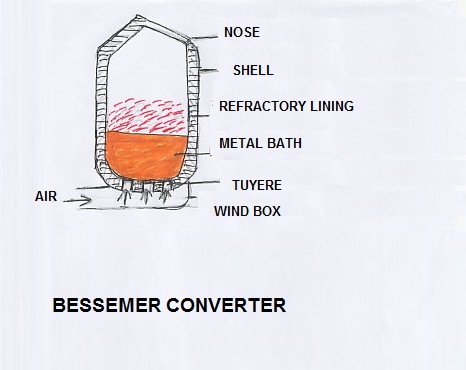Manufacture of Steel

Prior to the introduction of the blast furnace, iron was reduced as solid metal by heating a mixture of iron ore and charcoal in a hearth type furnace. To produce structural metals,
the iron was heated in charcoal fire for sufficient time. Then it was cooled and hardened by cooling water. In this way the steel was produced. The mass scale quality production of
steel was popularized by Henry Bessemer in 1856 a.d. He attempted to speed up steel production by blowing air through molten iron. His process was modified by Thomas and basic steel
making process was popularized.
Bessemer-Thomas Process
This process has the basic principle of blowing air through molten pig iron present in the converter. The converter is made of steel plates with lining of refractory bricks. The type of
refractory bricks depends upon acid or basic process. When the iron ore is free of phosphorus and sulphur, the process is called acid process. In the acid process, silica bricks are used
in the converter.
Iron ore free from phosphorus and sulphur is not available in plenty. So, the basic process. was developed by Thomas. In the basic process, the converter has dolomite bricks as the lining.
This process removes phosphorus and sulphur from the molten metal. This process may be divided into three stages.
The first stage commences when the blast is put into the converter. The oxygen of the blast oxidizes the iron into ferrous oxide. The ferrous oxide mixes with the molten metal.
Then ferromanganese and ferrosilicon are added to the molten metal. The manganese and silicon have greater affinity for silicon.
The second stage commences after the oxidation of iron, manganese and silicon. When the temperature becomes very high, the carbon dissolved in molten metal starts burning.
The gas evolved during this stage is carbon monoxide. This carbon monoxide burns at the nose of the converter.
In the third stage, further addition of ferromanganese and ferrosilicon to the molten metal leads to removal of oxygen and other impurities. This process is an autogenously process.
No external heat is supplied in this process. Side blown converter was also developed to produce steel on a small scale for the foundary works. The pig iron was melted in a cupola furnace
and then put inside a converter. Oxygen rich air was blown from the side to the molten pig iron and refining was carried out. After the refining was carried out, the molten steel is put
into the casting for production of billets and implements.